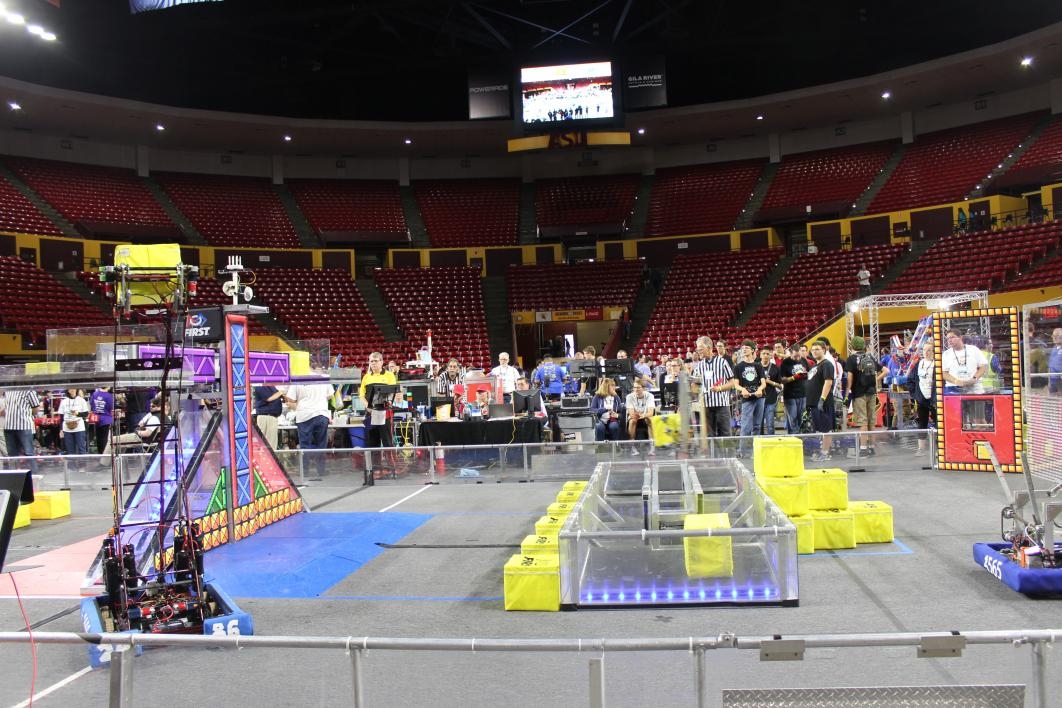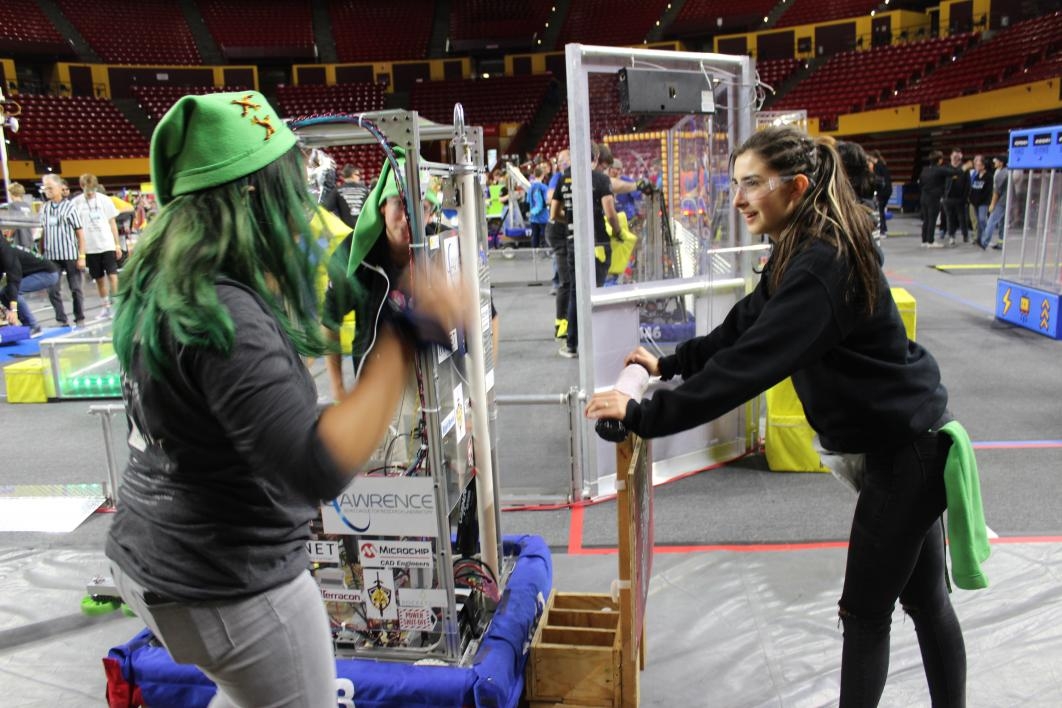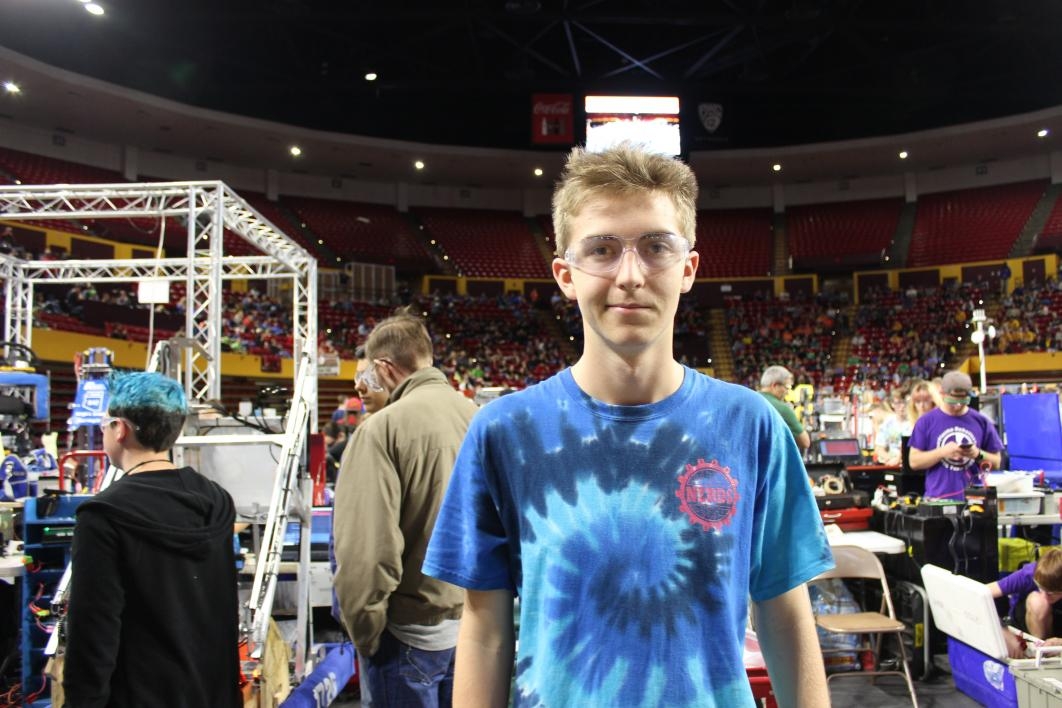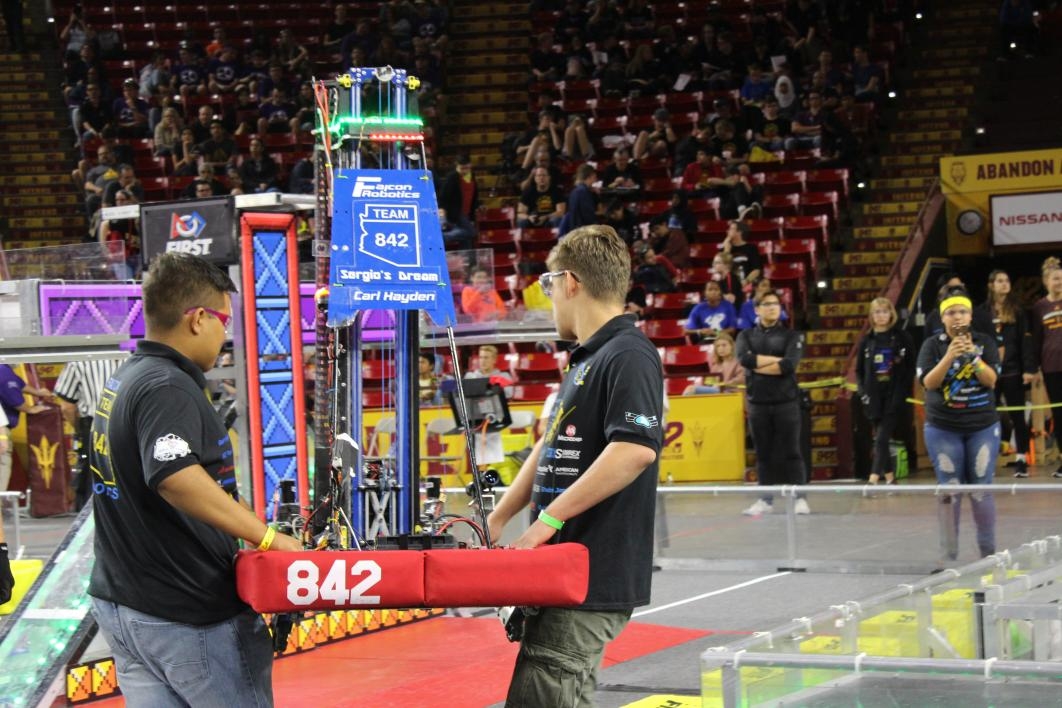FIRST Robotics Competition fosters learning, inspiration for Arizona high school students

Teams stage their robots at the FIRST Robotics State Championship on Oct. 13.
Under the lights at ASU’s Wells Fargo Arena, on an October afternoon, there was a different kind of battle going on. Not the normal basketball game or wrestling match but a competition with computers and robots: a “coopera-tition” as one coach called it.
“This is not battle bots,” said Nathan Bogardt, an English teacher and robotics coach at Buena High School in Sierra Vista, Arizona, which is southeast of Tucson. “Our goal here is not to destroy the other robots but instead use our robots to achieve a particular goal.”
Bogardt’s team, who call themselves the Nifty Engineering Robotics Design Squad (N.E.R.D.S.), was one of 30 high school robotics teams competing in the statewide FIRST Robotics Competition hosted by ASU’s Ira A. Fulton Schools of Engineering, the Sanghi Foundation and Access ASU. More than 500 students participated in the Oct. 13 event, which involved building robots to maneuver around and within an obstacle course.
“This program is to reignite the interest of our youth in science and technology,” said Steve Sanghi, president and founder of Microchip Technology Inc. “We accomplish that mission by teaming high school students with mentors from the industry and professional corporations in solving an engineering problem in a very intense and competitive way.”
The teams are grouped in a series of 3-versus-3 rounds, teaming up with others who, as Bogardt noted, could be previous or future opponents.
“The end goal of the competition is not just to build a winning robot, although that is fun too,” Sanghi said. “The end goal is to inspire the students and provide professional coaching so that there is personal growth for the students.”
ASU’s selection as the host venue for the competition is the result of a collaboration between the Sanghi Family Foundation, the Ira A. Fulton Schools of Engineering and Access ASU.
Sylvia Symonds, associate vice president of outreach with Educational Outreach and Student Services at ASU, says the event is an innovative way to open up pathways to careers and higher education.
“FIRST Robotics is a great vehicle to open up kids’ imaginations to think about science and technology in ways they might not have, absent their participation in this competition. The Sanghi Family Foundation’s commitment to sponsoring the FIRST Robotics competition is also a great example of how a wider range of stakeholders can help advance pathways and access to higher education for students starting at a young age,” Symonds said.
Representatives of the Fulton Schools of Engineering and Access ASU were on hand to talk with students and parents about opportunities at the university.
Hope Parker, associate director of K–12 engineering education and outreach for the Fulton Schools of Engineering, said those opportunities to persist and iterate are her favorite moments to witness. “Events like this give students the opportunity to test out engineering in a real-world setting. When things got tough the teams pulled together to innovate, problem solve and work with each other to come up with a solution,” Parker said.
Axel Adams, a junior on the Buena High School team, said that his skills, both inside and outside of robotics, have grown since joining the robotics team.
“Before starting robotics, I didn’t really know anything about making things, the design process or working with people,” Adams said. “But since then, I’ve learned how to use a lot of tools, building things and designing parts for our team, as well as working on a deadline. Working with a team is an amazing thing to learn to do and get good at.”
Adams, who is also involved with theater at Buena High School, serves as the team’s spokesperson and says that he hopes robotics can continue to grow.
Sanghi said that’s the goal of competitions like these.
“I am always wowed by the energy I see at these competitions,” Sanghi said. “When I walk the pits and ask the students how they built the robot, what challenges they ran into… I feel pleased that the students get it. They get what we are trying to do.”
Coming in on top at the end of the day were three first-place winners: Carl Hayden (High School) Falcon Robotics, Seton High Sentinels and Westwood (High School) Robotics. Sharing second place were the Saguaro High Sabercats, Plasma Robotics and Coconuts Coconino High School.
Aside from the results, students and mentors alike rose to the challenges, adapted and came away with great lessons on what it takes to build and create.
Adams, who is looking to pursue robotic engineering or public speaking as a career, said that his work on the robotics team has given him the experience to prepare him for college and ultimately the workforce.
Whatever career path competitions like this one takes students on, Sanghi said that the end game is the same.
“Their excitement gives me hope that this next generation will keep the entrepreneurship and innovation alive in this country, which is often the backbone of an economy,” Sanghi said.
Written by Bryan Pietsch
More Science and technology

Indigenous geneticists build unprecedented research community at ASU
When Krystal Tsosie (Diné) was an undergraduate at Arizona State University, there were no Indigenous faculty she could look to…

Pioneering professor of cultural evolution pens essays for leading academic journals
When Robert Boyd wrote his 1985 book “Culture and the Evolutionary Process,” cultural evolution was not considered a true…

Lucy's lasting legacy: Donald Johanson reflects on the discovery of a lifetime
Fifty years ago, in the dusty hills of Hadar, Ethiopia, a young paleoanthropologist, Donald Johanson, discovered what would…




